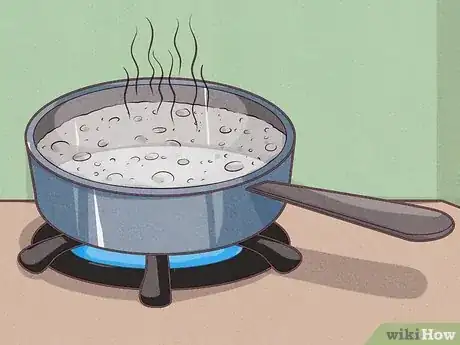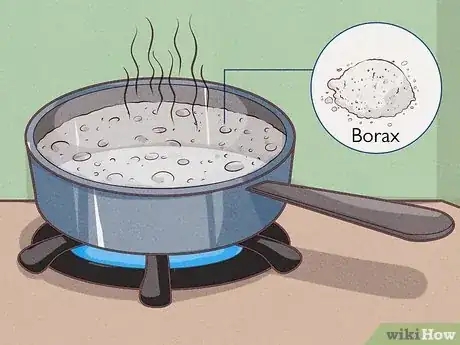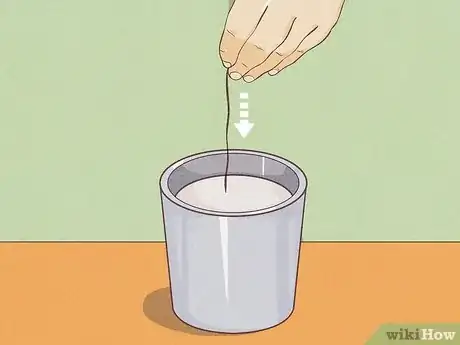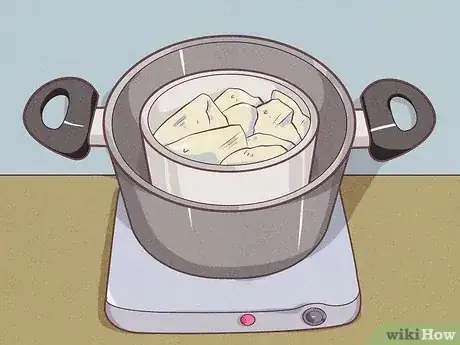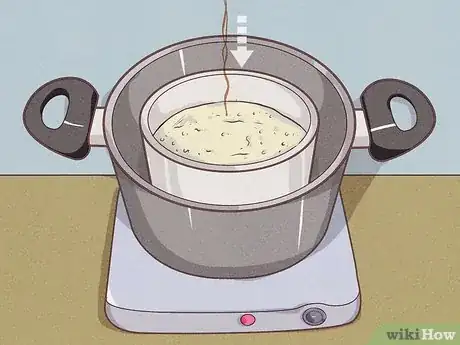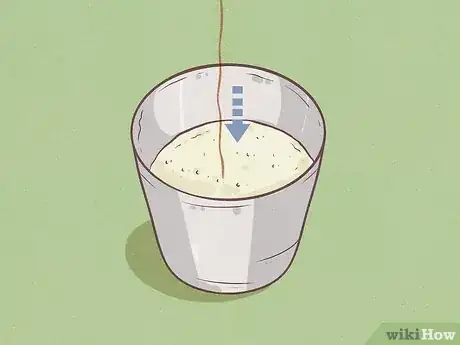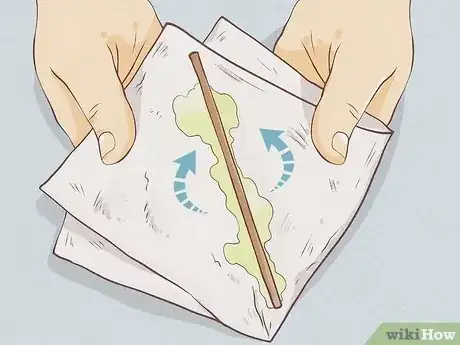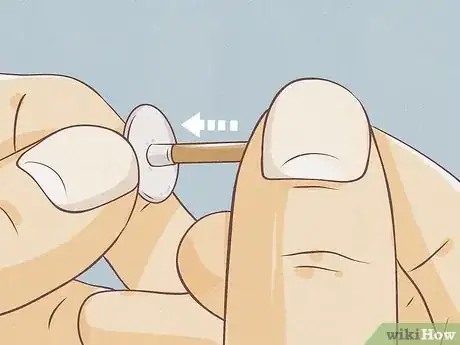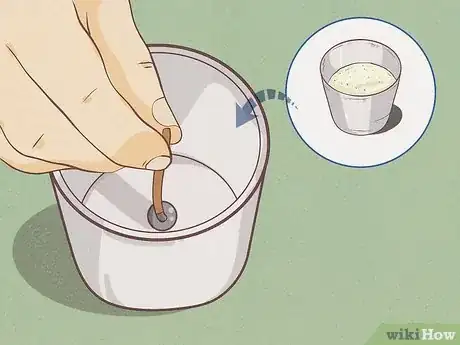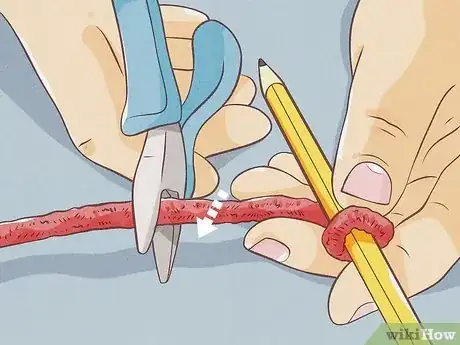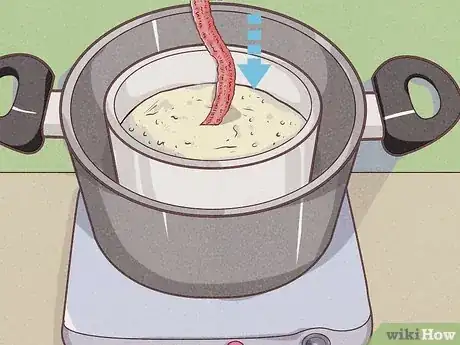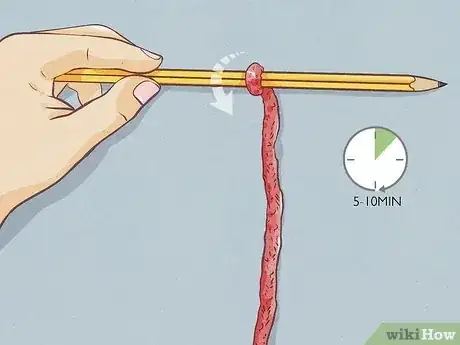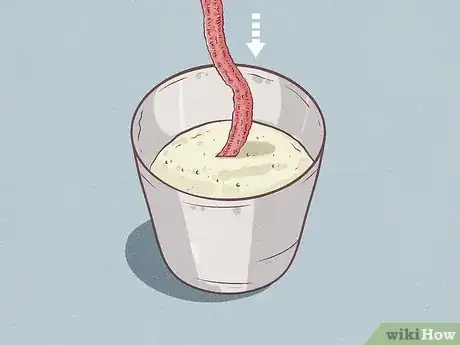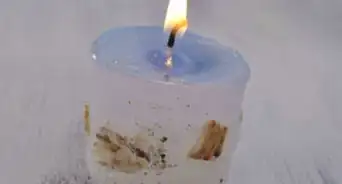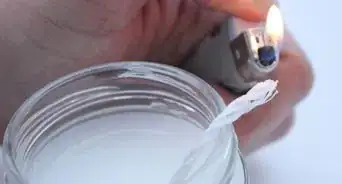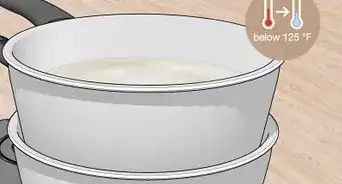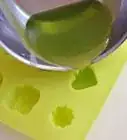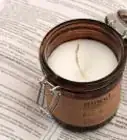This article was co-authored by wikiHow staff writer, Devin McSween. Devin McSween is a wikiHow Staff Writer. With a background in psychology, she has presented her research in social psychology at a variety of conferences and has contributed to several manuscripts for publication. At wikiHow, Devin combines her love of writing and research with the goal of bringing accessible information to wikiHow readers that will help them learn and grow. She earned her BS in Psychology from the College of Charleston.
There are 17 references cited in this article, which can be found at the bottom of the page.
wikiHow marks an article as reader-approved once it receives enough positive feedback. This article received 14 testimonials and 90% of readers who voted found it helpful, earning it our reader-approved status.
This article has been viewed 594,957 times.
Learn more...
You’ve got your candle wax, fragrant essential oils, and glass jar ready to go…when you realize you forgot candle wicks at the craft store. It’s a whole trek back into town, so is there any way to make your own candle wick at home? The great news is that there are super easy ways to make DIY candle wicks with supplies you might already have in your home! In this article, we’ll tell you how to make 3 different candle wicks. Read on to get crafting!
Things You Should Know
- To make a cotton wick, soak twine in a Borax and salt solution for 24 hours. After drying for 2-3 days, dip the wick in candle wax.
- To make a wooden wick, soak a balsa wood stick in olive oil for 20 minutes. Then, attach it to a metal wick tab.
- To make a floating wick, wrap one end of a cotton pipe cleaner into a circle. Cut the other end so it’s ½ inch (1.25 cm) above the circle. Dip it in candle wax.
Steps
Using Cotton Twine and Borax
-
1Bring 1 cup (250 ml) of water to a simmer. Pour 1 cup (250 ml) of water into a small saucepan or a tea kettle. Heat it over medium-high heat until it reaches a simmer, but not a full boil.[1]
-
2Pour 1 tbsp (19 g) of salt and 3 tbsp (43 g) of Borax into the water. Treating wicks with Borax can help candles burn brighter, longer, and reduce the amount of ash and smoke produced from the wick. Turn off the heat and add 1 tablespoon (19 g) of salt and 3 tablespoons (43 g) of Borax to the hot water. Then, mix the solution with a spoon to fully dissolve the salt and Borax.[2]
- If you don’t want to use Borax, simply dissolve the salt in hot water. Or, skip making a solution altogether and dip your twine in the melted wax as described in the steps below.
- Keep Borax away from pets and children. Borax, or sodium borate, can be an irritant when it’s inhaled, with some people experiencing coughing, sore throat, and shortness of breath after breathing it in. It can also irritate your skin, so wear gloves when handling it. It is also considered toxic when it’s ingested.[3]
Advertisement -
3Cut your cotton twine and soak it in the solution for 24 hours. Take a piece of heavy cotton butcher's twine and trim it so it’s about 1 inch (2.5 cm) taller than your candle container. Then, submerge it in the Borax solution. Set your pan in a safe location where it won’t be disturbed and let the twine soak for 24 hours.[4]
- If you don't know how tall your candle will be, soak up to 1 foot (30.5 cm) of twine and trim it down to size later.
- Almost any cotton cord like string, embroidery floss, torn pieces of cotton cloth, clean mop strings, and a clean shoelace will work in place of butcher’s twine.
- Linen, hemp, and jute twine are great alternatives to cotton twine, too.[5]
- If you’re feeling really crafty, use cotton balls or waxed dental floss! Grab a piece of cotton and twist it as you pull it out of the ball.[6] With floss, braid several strands together to make a thick wick.
-
4Hang the twine to dry for 2 to 3 days. Using tweezers or tongs, remove the twine from the Borax solution. Then, use a clothespin, clip, or hanger to hang the treated twine in a warm, dry location for 2 to 3 days. Place aluminum foil beneath the twine to catch any excess solution as it drips off.[7]
- It’s normal for crystals to form on the twine in the solution, so just wipe them off with a gloved hand.
-
5Melt ¼ to ½ cup (56-115 g) of candle wax over a double boiler. Break or cut your candle wax into chunks. Then, melt the wax using a double boiler. Simply fill a saucepan with 2 inches (5 cm) of water and set a smaller pan or heat-safe bowl on top of it. Place your wax chunks in the bowl and heat the saucepan over medium heat until the water is simmering.[8]
- Wear oven mitts or thick gloves when handling melted wax. It becomes very hot and can potentially burn you if it accidentally drips onto your skin.
-
6Dip the twine into the melted wax. Coating the twine in wax helps make the wick stiffer, easier to handle, and can make the flame easier to catch, too. Just carefully dunk the dry, Borax-treated twine into the melted wax. Swirl it around to coat as much of the twine as possible.[9]
-
7Hang the twine to dry for 5 to 10 minutes. To keep the twine straight as it dries, hang it up using a clothespin, hook, or clip. Place a sheet of aluminum foil beneath the twine to catch any excess wax dripping off. Then, let it dry and harden for several minutes.[10]
-
8Dip the twine into the wax 1 to 2 more times. If you want to build up a thick coating of wax on your wick, repeat the dipping and drying process 1 to 2 more times. This is optional, but creates a stiffer wick that can make it easier to insert in the candle.[11]
- If you don't have enough wax to dip the string again, lay the wick on a sheet of aluminum foil and carefully pour the remaining wax on top. Let the wick dry on the foil instead of hanging it again.
-
9Place your wick inside a candle. Once the fully-coated wick is dry, it's ready to be used! Insert your wick into a metal wick sustainer tab and adhere it to the bottom of your container with wax. Then, pour in your favorite wax to make your candle[12] .
Using Balsa Wood
-
1Trim down a balsa wood stick to fit in your container. For the best candle burn, cut your wooden wick so it’s about 1 inch (2.5 cm) taller than your chosen candle container.[13]
- Both round and flat balsa wood strips work as a wick. Just make sure they’re about ½ to 1½ inches (1.25-3.75 cm) wide.
- Wooden dowels and thin strips of untreated wood like oak, cherry, and birch make great alternatives to balsa wood.[14]
- If you don’t know how large your candle will be, cut the wood down to a length between 6 to 12 inches (15.25-30.5 cm) long. You can always cut it down later, so it's better to have too much than too little.
-
2Soak the balsa wood in olive oil for 20 minutes. Coating the wood wick in oil helps the flame catch quicker and burn more evenly. Just place the trimmed balsa wood into a shallow dish. Then, pour enough room-temperature olive oil into the dish to completely cover the wood. Let it soak for 20 minutes to 1 hour.[15]
- As an alternative to olive oil, use coconut oil, avocado oil, or palm oil. These oils burn cleanly like olive oil.
-
3Wipe away the excess oil on the balsa wood. Remove the wooden wick from the oil. Using a clean paper towel, wipe away the excess oil dripping off the wick. Once the excess oil is removed, the wood should feel slightly damp and oily to the touch, but not so oily that it leaves residue on your hands.[16]
- Instead of rubbing the wick dry, just place it on a plate covered with paper towels to let it air dry for several minutes.
-
4Attach a metal wick tab to the end of the stick. To get your wooden wick to stay upright, attach it to a metal wick tab or sustainer. Simply open up the tab with a pair of small pliers and carefully push one end of the treated wood into the opening. Then, clamp the metal around the wick to secure the wick inside.[17]
-
5Use your wick inside a DIY candle. When you’re ready to make your candle, just attach the metal wick base to your candle container with some wax. The balsa wood wick crackles slightly when it burns, making it a great wick to pair with a woodsy scent.[18]
Using a Pipe Cleaner
-
1Melt ¼ to ½ cup (56-115 g) of candle wax in a double boiler. Break apart your candle wax or paraffin and place it into a small saucepan or heat-safe bowl. Pour about 2 inches (5 cm) of water into a larger saucepan and heat it to a simmer over medium heat. To melt the wax, place the bowl of wax over the large saucepan.[19]
- This type of wick just rests on the top of a candle–it is not inserted in the wax. As the wick burns, it melts the wax and creates a pool that the wick floats on top of.
- If you don’t want to use new wax, use the wax from old candles. Just break the wax into small chunks so that it melts quicker.
-
2Twist the end of a pipe cleaner around a pencil. Wrap the end of an all-cotton pipe cleaner around the side of a pencil or pen. Once the pipe cleaner forms a circle around the pencil and slightly overlaps itself, pull the remainder of the pipe cleaner up so that it's vertical and running parallel to the side of the pencil. Then, slide the pipe cleaner off of the pencil.[20]
- Pipe cleaners made with synthetic fibers may not burn as well as all-cotton pipe cleaners.
-
3Trim the pipe cleaner to fit inside your candle container. Use side cutter pliers to cut the long end of the pipe cleaner about ½ inch (1.25 cm) above the circular base. Then, use needle-nose pliers to carefully pull the long end of the pipe cleaner toward the center of the circular base.[21]
-
4Dip the wick into the melted wax. Grab the trimmed pipe cleaner wick using long-handled tweezers and carefully lower it into the melted wax. Swirl it around in the wax for several seconds so the entire wick is coated.[22]
- Wear oven mitts or thick gloves when dipping the wick in the melted wax. The wax is very hot and can burn your unprotected skin if it splashes on you.
- Keep your hold on the wick with tweezers, as it may be difficult to get out if you simply drop it in the wax.
-
5Let the wick dry for 5 to 10 minutes. Remove the wick from the wax and set it with its circular base down on a sheet of aluminum foil. Wait several minutes for the wax to dry and harden. When it’s completely dry, it will be cool to the touch.[23]
-
6Dip the wick in wax 1 to 3 more times. A thick coating of wax stabilizes your wick and helps it burn quickly and for a longer period of time. Just repeat the dipping and drying steps 1 to 3 times, letting the wax harden in between coats.[24]
-
7Center the wick on top of a wick-less candle. Once the wick is completely dry, it’s ready to use. Just fill your container with candle wax, let it dry, and place the wick directly on top.[25]
Community Q&A
-
QuestionCan I substitute TSP, washing soda, borax substitute, or citric acid for Borax?
 wikiHow Staff EditorThis answer was written by one of our trained team of researchers who validated it for accuracy and comprehensiveness.
wikiHow Staff EditorThis answer was written by one of our trained team of researchers who validated it for accuracy and comprehensiveness.
Staff Answer wikiHow Staff EditorStaff AnswerNo, Borax is the best solution to use on a cotton wick. However, you don't have to use Borax at all. Just soak the cotton twine in a saltwater mixture to stiffen it. Or, simply dip it in melted wax.
wikiHow Staff EditorStaff AnswerNo, Borax is the best solution to use on a cotton wick. However, you don't have to use Borax at all. Just soak the cotton twine in a saltwater mixture to stiffen it. Or, simply dip it in melted wax. -
QuestionCan toothpicks be used in place of balsa sticks?
 wikiHow Staff EditorThis answer was written by one of our trained team of researchers who validated it for accuracy and comprehensiveness.
wikiHow Staff EditorThis answer was written by one of our trained team of researchers who validated it for accuracy and comprehensiveness.
Staff Answer wikiHow Staff EditorStaff AnswerYes, you can use toothpicks for small candles like tea candles. Just trim the toothpick so it is a bit taller than your candle container. Then, soak it in olive oil like you would with the balsa stick.
wikiHow Staff EditorStaff AnswerYes, you can use toothpicks for small candles like tea candles. Just trim the toothpick so it is a bit taller than your candle container. Then, soak it in olive oil like you would with the balsa stick. -
QuestionIs there an easier way to make candle wicks?
 Community AnswerYes. You can simply dip a string in melted wax and allow it to dry. Then you can make a candle without using borax or wood.
Community AnswerYes. You can simply dip a string in melted wax and allow it to dry. Then you can make a candle without using borax or wood.
Warnings
- Wear gloves and work in a well-ventilated area when using Borax, or sodium borate. Keep it away from children and pets too, as it can be an irritant when inhaled or touched. It is also harmful when it’s ingested.[26]⧼thumbs_response⧽
- Wear oven mitts or thick gloves when working with wax. Wax becomes very hot when melted and can burn if it accidentally drips or splashes onto your skin.⧼thumbs_response⧽
Things You'll Need
Using Cotton Twine and Borax
- Water
- Saucepan
- Table salt
- Borax
- Tweezers
- Cotton twine
- Clothespin, clip, or hanger
- Aluminum foil
- Double boiler, or 1 large and small saucepan
- Candle wax
- Metal wick tabs
Using Balsa Wood
- Thin balsa wood sticks, ½ to 1-½ inches (1.25-3.75 cm) wide
- Scissors
- Shallow container
- Olive oil
- Paper towels
- Metal wick tabs
- Pliers
Using a Pipe Cleaner
- All-cotton pipe cleaners
- Pencil or pen
- Tweezers
- Side-cutting pliers
- Needle-nose pliers
- Candle wax or paraffin
- Double boiler, or 1 large and small saucepan
- Aluminum foil
References
- ↑ http://www.redtedart.com/2012/02/03/how-to-make-a-candle-wick/
- ↑ https://youtu.be/XrflifL2dH4?t=12
- ↑ http://npic.orst.edu/factsheets/boricgen.html#
- ↑ https://youtu.be/VwPq0TXNGEg?t=35
- ↑ https://justcraftingaround.com/how-to-make-candle-wick/
- ↑ https://youtu.be/fWsosXb2NGU?t=7
- ↑ https://youtu.be/OuFN79ep1ok?t=189
- ↑ https://youtu.be/XrflifL2dH4?t=41
- ↑ https://youtu.be/VwPq0TXNGEg?t=146
- ↑ https://youtu.be/VwPq0TXNGEg?t=177
- ↑ https://www.candlemakingfun.com/how-to-make-candle-wick/
- ↑ https://justcraftingaround.com/how-to-make-candle-wick/
- ↑ https://justcraftingaround.com/how-to-make-candle-wick/
- ↑ https://www.candleers.com/wooden-candle-wicks-for-beginners/
- ↑ https://candlepursuits.com/what-should-i-soak-wood-wicks-in/
- ↑ https://www.candlemakingfun.com/how-to-make-candle-wick/
- ↑ https://www.candlemakingfun.com/how-to-make-candle-wick/
- ↑ https://cxndle.com/how-to-make-a-candle-wick/
- ↑ https://cxndle.com/how-to-make-a-candle-wick/
- ↑ https://www.kathymakesstuff.com/blog/tin-can-candles
- ↑ https://cxndle.com/how-to-make-a-candle-wick/
- ↑ https://www.kathymakesstuff.com/blog/tin-can-candles
- ↑ https://cxndle.com/how-to-make-a-candle-wick/
- ↑ https://www.kathymakesstuff.com/blog/tin-can-candles
- ↑ https://www.kathymakesstuff.com/blog/tin-can-candles
- ↑ http://npic.orst.edu/factsheets/boricgen.html#
About This Article
To make candle wicks, start by purchasing balsa wood sticks from a craft shop or online. Then, use scissors to trim down a stick so it’s about 1 inch taller than the container you plan to use for the candle. Once you’ve trimmed the stick to the right length, place it in a shallow dish and soak it in olive oil for at least 20 minutes to help it burn. When you take the stick out, wipe away any excess oil with a paper towel or let it air dry for a few minutes. After your stick has dried, push 1 end into a metal wick tab to hold it in place when you make your candle. For more tips, including how to make candle wicks with Borax, read on!
